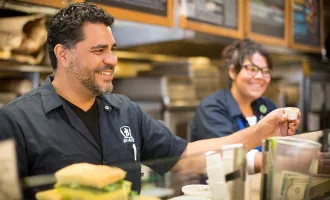Wine Tasting on a Student Budget
If you happen to be a consistent reader of my column, then in the past week, you’ve spent $3,000 to $8,000 on a new old car. You’ve finished with the background research, the ad search, the haggling, the loan and the tune-up, and perhaps now it’s time to sit down for a glass of wine.
A trip to the wine aisle at your favorite shop can leave you feeling overwhelmed and stumped as you stare blankly at the walls of hundreds, if not thousands, of choices, ranging from roughly $2 to $250 per bottle.
Rather than make a slew of specific recommendations, I’ll try to walk you through how you might develop your own style for wine selection — and of course, on a budget that’s right for you.
Step 1: Throw a Party
I firmly believe this is the first step in the process of increasing your wine IQ. Gather seven or eight of your best friends who enjoy sharing their opinions, set a general theme, have each person bring a food item and some cash for wine, and give everyone a sheet of paper to write down their impressions of each wine.
For $10 to 20 per person, everyone can have a full meal, taste half a dozen or so wines, and have a lovely evening.
For the purpose of training your wine palate, it is better if you choose all the wines for the party rather than having each person bring a bottle, as people are likely to make “safe” choices, thereby defeating the purpose of trying to expand your appreciation for the spectrum of wines that exists.
Remember, having a wine you don’t like often helps you put your finger on just what qualities make up the ones you do like, so don’t be afraid. No reason is too silly for choosing a bottle — labeling, descriptions, eenie meeny miney mo, a discounted bottle on sale or recommendations from the person at the shop.
How many wines to buy and what varieties?
This obviously varies based on your friends’ thirst, but a decent starting point is to plan for 500-600 milliliters (four to five average-size glasses) per person over the course of an evening. As most wine bottles hold 750 milliliters, plan on six bottles of wine for a party for eight to nine people. Initially make the pours about 3 ounces. If people really like a certain wine, this allows them to have a little more, and there is less waste if someone really does not like a wine.
I tend to buy two whites and four reds for an evening like this. I choose one white that is light and sweet for the beginning of the get-together, as people may still be showing up. Rieslings and Gewurztraminers are ideal for this purpose.
As California has an abundance of great Chardonnays, I often select one to bridge the group into the dinner portion of the evening, as their smooth, buttery flavors often pair well with salads, fruits, mild curries or cream sauces. Be sure to chill the whites prior to serving.
As the evening goes on, a reasonable approach is to transition from simpler to more complex flavors, with both wines and foods following this trend.
Pinot noirs make good choices for first red of the evening, as they are smooth with a crisp finish, and even clumsy wines are generally drinkable. Because these grapes tend to be grown in smaller crops (thereby raising the cost of production), don’t expect to be blown away by many inexpensive Pinot noirs, and let me know if you find one that does so.
For the next wine, I often choose a Merlot or a Syrah/Shiraz (different word, same wine). These tend to feel smooth in the mouth with moderate acidity and fairly forward but approachable flavors. Both of these wines pair well with savory main dishes, including grilled meats, stews and the like, while still leaving your palate able to taste things to come.
The next couple wines can be any of several choices. I usually put at least one curveball in here — whether that means something from an obscure part of the world not typically known for its wine, an interesting blend of grapes not often seen together, or a wine you bought simply because it was recommended by your favorite rock star.
I’ll make an exception to my not using this article to recommend specific wines and promote Rosenblum Cellars’ “Stark Raving Red,” a bold blend of fruit, acid and tannin, with layers of flavor.
The wines at the end of your list should be the most complex. You’ll be well warmed up and able to appreciate and discuss the flavors of Cabernet Sauvignons (arguably the most recognized red wine worldwide), Zinfandels and the like.
There are infinitely many Cabernets out there. The classic profile includes a dark fruit, a peppery spice, high acidity, a woody age and a powerful flavor that increases in smoothness with age and finishes with a coarse feel on the tongue.
These classically pair well with beef, but are really great with anything with lots of rosemary. In my opinion, Zinfandels offer the biggest flavors at the lowest cost, and several of the Zins out of the Lodi area are high on my list.
Their flavors keep up with hearty dishes with thick sauces, and even young wines have full flavors. For all these reds, the ideal serving temperatures are slightly cooler than room temperature. I often chill the bottles for about 20 minutes prior to serving.
Does it matter how I drink it?
A clear glass allows you to appreciate the color and clarity of the wine, and tilting the glass lets you see the viscosity. I never fill the glass more than 40 percent full. This way, you can swirl the wine vigorously to bring the aroma to the tip of the glass as you smell it.
Some experts recommend putting a small amount of wine in your mouth at this point, slurping to incorporate air into your sip, and noting the aftertaste after spitting, but I think they’re silly. Take a swirl, a sniff, a sip and then swallow. Then take a bite of a food that seems as if it has flavors complementary to the wine, and take another sip and see how the food changes the character of the wine.
What about price?
I believe even the most special occasions and/or meals can be celebrated with excellent wines for under $40, but there are certain characteristics that might take someone into the range of bottles that cost hundreds or thousands of dollars, once they’ve developed specific likes and dislikes.
For wine consumed on a consistent basis, I have a useful spending tip that ties in with car buying — specifically, that the amount you can comfortably afford to spend on a regular bottle of wine should be roughly equal to the number of thousands of dollars you can afford to spend on a car.
That is, if you can afford a $6,000 to $8,000 car, you can afford to buy a $6 to $8 bottle of wine on a regular basis. Happy tasting, and cheers.


